NARA projects on course to improve fish harvesting
By Mohammed NAALIR
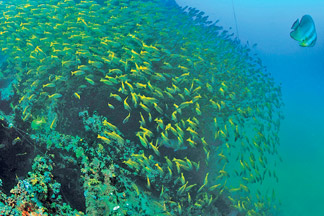
Fish near a ship-wreck
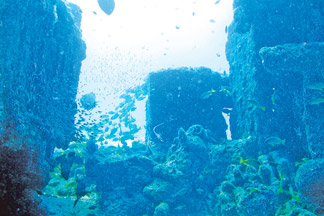
A fish base identified by NARA
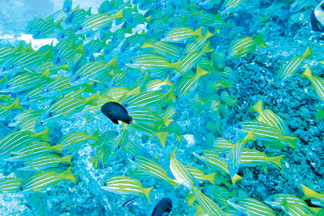
A fish base identified by NARA
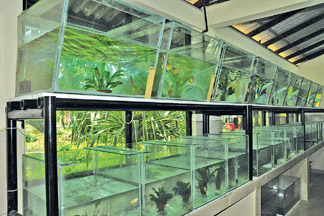
A fish tank at NARA |
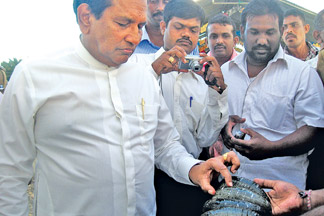
Fisheries and Aquatic Resources Development Minister Rajitha
Senaratne inspecting sea cucumber |
The National Aquatic Resources Research and Development Agency (NARA)
will implement the marine related policies of Fisheries and Aquatic
Resources Development Ministry, Dr. S.G. Samarasundara Chairman of NARA
said.
Several departments come under the NARA, namely the Institute of Post
Harvest Technology (IPHT), Oceanography Division (OD), Inland Aquatic
resources and Aquaculture Division (IARD), Information Technology
Division (ITD), Socio-economic and marketing division (SED) and Marine
Biological Resources Division (MBRD).
The IPHT plays a key role in making fishermen and the handlers of
fish aware in preserving fish after the harvest. It is introducing fish
processing technologies from time to time and improving hygienic
processing techniques for traditional (dried fish, Maldivian fish and
jaadi) and new fish products.
IPHT is paying close attention towards preserving the quality of
fish. These activities will help NARA to minimise the fish wastage after
the harvest and to achieve the goal of eliminating malnutrition from the
country.
Daily a considerable percentage of fish is going waste due to bad
handling at fisheries harbours and stalls.
NARA is conducting research and awareness programs on good fish
handling practices to minimise post harvest losses and to improve
hygiene.
The IPHT provides technology for dry fish, Maldivian fish, Smoked
fish, Fish Ambulthiyal, Jaadi, Fish balls, Fish sausage, Fish soup mix,
Shark fin soup, Steam dried Shrimp, Fish pickle, Fish sauce, flavours
using prawn heads, Sea weed jelly, Oyster sauce, use of fish waste to
produce biogas, fish meal and fish sailage etc.
Fisheries industries
The IPHT also provides laboratory and consultancy service on
microbiological assessment, chemical analysis and quality control.
Quality control laboratory provides testing service to the fisheries
industries. Since 2004 NARA is providing this service.
NARA earned an income of Rs. 5 million in 2010 and Rs. 4 million in
2011 providing laboratory service.
Dr. Samarasundara said that moves are underway to increase the profit
to Rs. 7 to 8 million this year.
It also conducts research on human health hazards due to
contamination of fish and fishery products, Dr. Samarasundara said.
IPHT is mainly focusing attention on microbiology, Chemistry, Food
science and Technology, Quality Assurance and fish processing and
product development.
The IPHT will conduct tests from the pharmaceutical extractions from
marine organisms for anti-cancer and viral properties in collaboration
with private laboratories this year.
Fish and seaweed processing technology will also be transferred to
the community as an alternative income earning mode. Providing
guidelines for seafood retailers with a view to supply quality fish to
consumers is another focus for this year, according to Dr.
Samarasundara.
The IPHT also supports the Divi Neguma program. Over 2,100 fish
processors have benefited so far.
As a pilot project NARA plans to produce fish balls, dried fish, Fish
Ambulthiyal and Jaadi and distribute them to Fisheries Corporation
stalls for sale. On its success, this project will be handed over to
Government or private sector to develop the industry.
On the instruction of Fisheries Minister NARA plans to set up model
fish stalls. One stall will be set up in each province.
The stalls will be set up in required temperature. In general, nobody
focusses much attention on temperature or hygiene when a stall is set
up. The people can take this as a model when they are setting up fish
stalls. The first stall will be set up in Kalutara.
NARA also plans to to set up billboards at fisheries harbours
displaying the information what should be done and what should not be in
the harbour premises. This will help preserve the quality of fish.
Dr. Samarasundara said that the Fisheries Harbour Corporation is
doing a yeoman service in developing the harbours and keeping them
clean.
Nine projects
Inland Aquatic Resources and Aquaculture Division (IARAD) also plays
an important role in improving the fisheries industry in the country.
IARAD is engaged in a lot of research work such as inland aquaculture
development, conservation of sensitive habitats, shrimp culture, coastal
resources management, ornamental fish culture, health management and
aquatic plant propagation.
University students too benefit through this division.
IARAD has proposed nine projects for 2012.
It focused attention on breeding of ornamental fish, sea cucumber,
seaweed, muscles, oysters.
These industries would bring lot of foreign exchange to Sri Lanka if
they were developed systematically.
Sea cucumber is one of the main and expensive food in the foreign
countries. In Sri Lanka sea cucumber was taken from wild for export. As
this would cause severe destruction to the nature the NARA found a
technology to breed new sea cucumber.
The new technology will help export more and more sea cucumber
without causing damage to the natural structure.
NARA has drafted a proposal to set up sea cucumber hatcheries. The
willing sea cucumber breeders can get their needed quantity from NARA.
Only eight months old sea cucumber can be marketed. With a view to
ease the burden of low income earning families NARA plans to breed sea
cucumber in its ponds and give the breeders after five months. NARA
plans to use the abandoned prawn farms for this purpose. Breeding of sea
cucumber will be promoted even under the Divi Neguma program.
Oyster-:There are three to four oyster beds in the coast of Sri
Lanka. NARA has identified oyster beds in Mannar, Puttalam and
Batticaloa. Batticaloa is considered the best location for oyster.
NARA has deployed a research team to monitor these lagoons and to
provide information to institutions like NAQDA from time to time on
these oyster beds to prepare a better management plan. NARA has also
started oyster projects in the Batticaloa area as pilot projects.
Monitoring project
It is also conducting a monitoring project in Mannar lagoon to find
out how to popularise oyster production among the public.
Muscles-:NARA has started a project in Trincomalee under the Divi
Neguma program. The muscles will be ready for harvest in a two months.
The public in that area can generate better income from it. Seaweed- An
extensive research on seaweed industry has also been conducted. The
enterprises which are engaged in sea food industry are also keen to take
part with NARA to promote seaweed industry.
Ornamental fish-: It is a huge industry in the world. Sri Lanka has
enough endemic ornamental fish. NARA has realised the necessity to
develop this industry. Training programs are being conducted free of
charge by them for those who are willing to start this industry as a
self-employment program.
On the instructions of Fisheries Minister Rajitha Senaratne NARA has
developed a tank systems to breed endemic ornamental fish. Sri Lankan
ornamental fish is still very expensive in foreign markets.
Oceanography Division is also one of the main divisions of NARA and
it is looking at two main areas.
One is satellite based fishery forecasting that gives correct and
timely information of fish to fishermen. Under this project forecast
maps are issued to fisheries harbours every week.
This will help fishermen identify the places where enough fish is
available. On the other hand, this project will prevent fishermen from
going missing and experiencing losses.
Dr. Samarasundara said that NARA conducted several researches in the
past to identify fish breeding places in Sri Lankan seas. The fisheries
harbours will be informed through fax or telephone of the places where
there are ample fish. Then the fishing vessels could be sent to those
places. Only the fishing vessels which is registered with NARA will be
entitled for this benefit.
Ocean observation centre monitors the ocean on in changes, keeping
alert on worldwide earthquakes and inform responsible institutions and
departments regarding possible tsunami occurrences and promote pre
preparation for ocean based disasters.
Mineral exploration
The Fisheries Ministry has implemented a Vessel Monitoring System
(VMS) which is nearing completion and will be implemented soon, Dr.
Samarasundara said. When the VMS is implemented it will be very easy for
NARA to directly contact the boat provide information.
With the increase of fuel price, the fishermen should be helped to
prevent them from roaming in the sea for fish. Fuel waste can also be
minimised after the implementation of VMS system.
The Oceanographic Department is engaged in heavy mineral exploration.
On the off-shore of Sri Lanka there may be very heavy mineral deposits.
A survey off the west coast is in progress.
A total of 365 million cubic metres off shore sand is found off the
west coast. There are so many sunk ships of aggrigator value and
archaeological value, Dr. Samarasundara added. |

